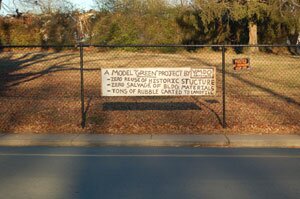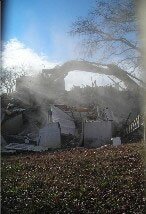ONARCHITECTURE- Demolition fall-out: Lost chance or new beginning?

Preservation protest: This homemade sign was spotted hanging on the fence around the demolished Beta House on January 3.
The unapologetic demolition of the former Compton House, a.k.a. Beta House, on Maury Avenue by the Jefferson Scholars Foundation and VMDO Architects, which occurred two days after Christmas, has angered and saddened many local preservationists, including the city's own Preservation and Design Planner, Mary Joy Scala, who presented a plan to better protect historic properties at a January 7 City Council meeting.
Before council, UVA architectural historian Daniel Bluestone called the demo "disgusting" and "a day of vandalism in our commons" that was paid for with public funds. "We are all responsible," he said, "and we need a strategy to hold on to the heritage of our city." He ended by handing each councilor one of the expensive terra cotta roof tiles from the demolished Compton House to be used as a paper weight, and a reminder.
The December 27 demo also inspired some creative vandalism from preservationists. A makeshift sign appeared on the fence surrounding the property last week (see photo) that mocks VMDO Architect's decision to demolish the structure.
VMDO's Bob Moje calls the sign a "juvenile prank" by someone poorly informed about the project.
"This is a LEED [a recognized industry standard for green building] project, and considerable effort is being made to make the project green and environmentally friendly," says Moje. "VMDO is a leader in this area, and our record speaks for itself."
Indeed, the Foundation wants to build a new $21 million environmentally friendly headquarters on the Beta House site.
However, for Scala and others, demolishing the house was a step in the wrong direction.
"The Beta House is a lost opportunity to demonstrate that preservation is the cornerstone of sustainability," Scala says.
Indeed, many preservationists argue that preserving buildings is the most practical way to build green, the equivalent of recycling and reuse.
Preservationist Aaron Wunsch and others argue that demolishing a building the way the contractor did– using a single back-hoe operator who simply smashed the house to bits, a method Moje calls the "least expensive" and most "efficient" method (a visit to the site revealed that the operator smashed his own windshield in the process )– amounts to not only destruction of a historic building, but a colossal waste of existing resources.
However, as Moje points out, the pile of debris will undergo environmental testing, primarily for the safety of the workers, and then materials will be sorted for re-use before being taken to a landfill.
But Wunsch suggests that VMDO may be missing the point.
"An important issue raised by the demo involves the relationship between preservation and 'green' building," he says. "This is a hot topic in the preservation world right now. Is it possible to demolish a massive historic structure and then declare its successor environmentally correct? The answer, I think, hinges on what preservationists call 'embodied energy'– the amount of labor and resources that a given building consumed in its production."
Of course, there are also questions about the way the Foundation went about the process. In June, City Council approved an $18 million bond issue for the Foundation. According to Mayor David Brown, there was no mention from the Foundation about possible demolition. Besides, Brown says that Council members believed– naively perhaps– that a foundation bearing Jefferson's name and associated with UVA would surely be dedicated to historic preservation.
"Who would have thought it was their intent to tear it down?" Brown asks.
Later, when the Foundation came before Council seeking an additional $3 million in bond financing, Brown says that having been "burned badly" earlier led Council to deny the bond request. "We wanted to know what their plans for the building were," he says, "but they didn't come back to us."
Now that the building is gone, Brown and his fellow councilors and are hoping the unfortunate demo might lead to changes in the way buildings are designated historic. During the January 7 City Council meeting, Dave Norris, Satyendra Huja, Holly Edwards, and Julian Taliaferro all appeared to be in favor of better protecting historic properties. Taliaferro said, "We need to act, with all due haste." And responding to Bluestone, Brown said, "I deeply regret we didn't take a closer look."
Scala then presented a plan to create a new category of historic oversight, a kind of "historic district lite," that would provide a level of design review to please both preservationists and property owners. She also presented a long list of historic and architecturally significant properties to be considered for protected status, such as the Coca Cola bottling plant on Preston and the Fry Springs Service Station.
Indeed, the Beta House was never declared a historic landmark or one of the city's 65 Individually Protected Properties, a fact that the Foundation used against arguments for preservation, saying, in effect, if this building was so important, why didn't the city declare it a landmark?
Wunsch thinks the reason is that the city's preservation office is under-staffed and under-funded. "Until that changes," he says, "the City's survey will continue to be idiosyncratic, but maybe this event will be a catalyst for change."
Indeed, a city council that feels "badly burned" by the loss of the Beta House appears to be ready to give city preservation planners more muscle.
As Scala points out, a successful historic preservation program must rely on regulation to prevent worse-case scenarios like destruction of the Beta House.
"But equally important," she says, "is the property owner taking responsibility."
For an ongoing discussion about Beta House and local preservation efforts, see the Hook's news blog at readthehook.com/blog. Type in search keyword "Beta House comes down."

After the residence stood for 93 years at 124 Maury Avenue, a lone back-hoe brought down Beta House in a matter of hours on December 27.
PHOTO BY DAVE MCNAIR
#